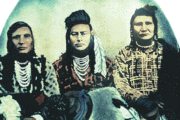|
|
Nez_Perce_warrior_on_horse.jpg
The Nez Perce or Nez PercÚ (pronounced , or as in French) are a tribe of Native Americans who inhabited the Pacific Northwest region of North America and adjoining regions at the time of the Lewis and Clark Expedition. Nez Perce is a misnomer given by the interpreter of the Lewis and Clark expedition at the time they first encountered the tribe in 1805. It is from the French, "pierced nose." This is an inaccurate description of the tribe. They did not practice nose piercing or wearing ornaments. The "pierced nose" tribe, though related to the Nez Perce, actually lived on and around the lower Columbia River, and in other areas of the Pacific Northwest.
Edward_S._Curtis_Collection_People_007.jpg
| Contents |
Traditional lands
Nez-perce-couple-teepee-1900.jpg
University of Washington Digital Collections
The Nez Perce territory at the time of Lewis and Clark was approximately 17,000,000 acres (69,000 km²). It covered parts of Washington, Oregon, and Idaho, in an area surrounding the Snake River and the Clearwater River. The Nez Perce, like many western Native American tribes, were migratory and would travel with the seasons, according to where the most abundant food was to be found at a given time of year. They were known go as far east as the Great Plains, hunting American Bison and fishing for salmon at Celilo Falls on the Columbia River. They relied heavily on quamash or camas gathered in the region between the Salmon and Clearwater River drainages as a food source.
Notable people
Probably the best known leader of the Nez Perce was Chief Joseph, who led his people in their struggle to retain their identity in the face of American encroachments on their land.
The Nez Perce language
The Nez Perce language is a branch of the Sahaptian family, which also includes several dialects of Sahaptin (note the spellings, -ian vs. -in). Together, these languages are grouped into the larger Penutian family, which also includes languages such as Cayuse, Klamath, and Chinookan. The organization of this linguistic family can be compared to often more familiar examples such as the Indo-European or Romance families, though presumably Penutian is in no way historically related to Indo-European languages.
Chief-joseph-1877-nodak.jpg
University of Washington Digital Collections
The grammar of Nez Perce has been described in the dissertations of Noel Rude (University of Oregon, 1985) and Harold David Crook (UCLA, 1999), in a grammar by Haruo Aoki (University of California Press, 1975) and a dictionary by Haruo Aoki (University of California Press, 1994).
What follows is a brief overview of Nez Perce grammar.
In Nez Perce, the subject of a sentence, and the object when there is one, can each be marked with for grammatical case, a morpheme that shows the function of the word (compare to English he vs. him). Nez Perce employs a three-way case-marking strategy: a transitive subject, a transitive object, and an intransitive subject are each marked differently. Nez Perce is thus an example of the very rare type of tripartite languages (see morphosyntactic alignment).
Nez-perce-chiefs-1899-camas-prairie.jpg
University of Washington Digital Collections
Because of this case marking, the word order can be quite free. A specific word order tells the hearer what is new information (focus) versus old information (topic), but it does not mark the subject and the object (in English, unlike this, word order is fixed — Subject Verb Object).
As it happens in many other Native American languages, a Nez Perce verb can have the meaning of an entire sentence in English. (This manner of providing a great deal of information in one word is called polysynthesis.) Verbal morphemes provide information about the person and number of the subject and object, as well as tense and aspect (e. g. whether or not an action has been completed).
The phonology of Nez Perce includes a phenomenon known as vowel harmony, as well as a complex stress system described by Crook (1999).
Nez Perce is a highly endangered language. While sources differ on the exact number of fluent speakers, it is almost definitely under 100. The Nez Perce tribe is endeavoring to reintroduce the language into native usage through a revitalization program, though at present the future of the Nez Perce language is far from assured.
Nez Perce horse breeding program
The Nez Perce tribe began a breeding program in 1995 based on crossbreeding the Appaloosa and a Central Asian breed called Akhal-Teke to produce the Nez Perce Horse. This is a program to re-establish the horse culture of the Nez Perce, a proud tradition of selective breeding and horsemanship that was destroyed in the 19th century. The breeding program was financed by the United States Department of Health and Human Services, the Nez Perce tribe and a nonprofit group called the First Nations Development Institute, which promotes such businesses in Indian country.
External links
- Official tribal site (http://www.nezperce.org/Main.html)
- Listen to Nez Perce being spoken (http://www.u.arizona.edu/~cashcash/bighole/redthunder.html)
- A map of American languages (TITUS project) (http://titus.uni-frankfurt.de/didact/karten/amer/namerim.htm)
- Nez Perce Horse Registry (http://www.nezpercehorseregistry.com/main.html)

